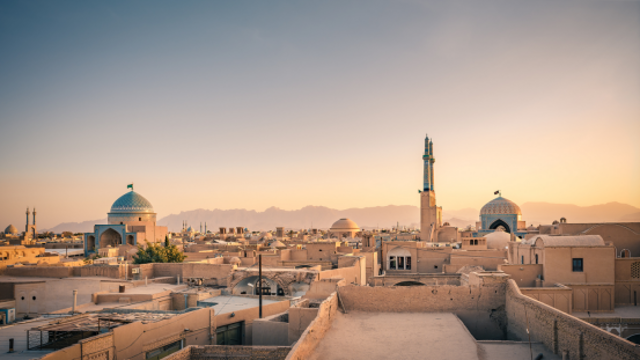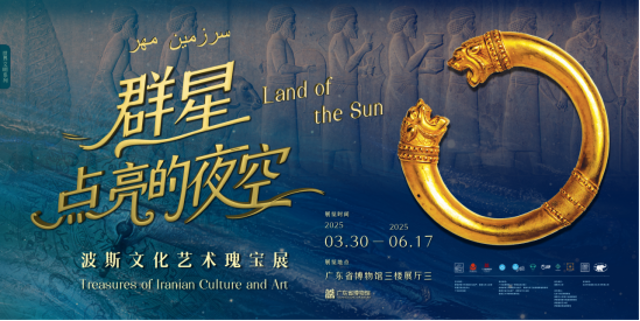The history of Iran is a tapestry woven with rich cultural threads, ancient traditions, and enduring legacies. At the heart of this vibrant heritage lies one of humanity's oldest civilizations, whose contributions to art, science, philosophy, and governance continue to influence the modern world and the new era.
The interactions between Iran and China, as two great ancient civilizations in West and East Asia, date back thousands of years. The Silk Road is a shared heritage from this era, and the cooperation between these two ancient civilizations has left a lasting legacy for the people of both nations and the world. Historical records, particularly those related to the Silk Road, narrate extensive political, cultural, and economic exchanges that were common between the ancient and esteemed civilizations of Iran and China.

Persian-style architecture in the historic city of Yazd, Iran. (Photo: cfp.cn)
Exhibition to honor China-Iran exchange at Guangdong Museum
Considering the significant role of cultural exchanges and people-to-people interactions between Iran and China in establishing strong, institutionalized, and strategic relations between the two nations, it is delightful that the year 2025 begins with bright horizons and prospects for multifaceted cooperation between Iran and China. On the eve of the Iranian New Year and the Chinese New Year, the opening of the exhibition "Land of the Sun - Treasures of Iranian Culture and Art" at the Guangdong Museum heralds a prosperous year for the growing relations between the two great and ancient civilizations and the historic nations of Iran and China.

(Photo: Guangdong Museum)
This exhibition is a valuable collection from the Reza Abbasi Museum, the Moghadam Museum of the University of Tehran, the Glassware and Ceramic Museum of Iran, the National Museum and the Carpet Museum of Iran. For the first time, it showcases the treasures of Iranian culture and art from 2000 BC to the 20th century. Visitors can admire exquisite ceramic vessels, bronze, gold, and silverware, glassware, Iranian textiles, Persian carpets, miniature paintings, and other artistic works. This cultural initiative reflects the utilization of shared capacities to bring nations and cultures closer together and represents a significant step toward deepening mutual understanding and cultural collaboration between the two nations.
Shared cultural implications between Iran and China
Nowruz, one of the oldest and most important Iranian festivals, has its roots in the history and culture of ancient Iran. This celebration, meaning "new day," marks the beginning of the new year in the Iranian solar calendar (the Hijri Shamsi calendar) and is held on the first day of spring, usually on March 21 (or March 20 in leap years). Nowruz symbolizes the renewal of nature, rebirth, and the triumph of light over darkness. During the Achaemenid era, Nowruz was recognized as an official national celebration.
In 2009, UNESCO inscribed Nowruz on the Representative List of the Intangible Cultural Heritage of Humanity, acknowledging its profound cultural significance and its role in fostering mutual understanding among diverse communities. In 2010, the United Nations General Assembly declared March 21 as International Nowruz Day, encouraging worldwide celebrations that highlight the festival's themes of peace, unity, and renewal.
Nowruz and the Chinese Spring Festival (also known as Chinese New Year) are both significant celebrations marking the beginning of a new year, sharing many cultural and traditional similarities. Nowruz and the Chinese Spring Festival herald the new year in their respective solar (March 21 - the first day of Farvardin) and lunar (between January 21 and February 20) calendars. Both festivals symbolize rebirth, hope for the future, and a fresh start.
Long-standing cultural relations between Iran and China
Ancient Persia and China were located at the eastern and western ends of the Asian continent, respectively. Both had established empires in history and boasted diverse cultural hues. They were the two major sources of civilization on the East and West of the Silk Road, with a long-standing relationship. Through the network of the Silk Road, ancient civilizations exchanged goods, shared ideas, and blended cultures, significantly promoting the development of human civilization.
Over the years, the bond of friendship and close relationship between Iran and China has continued without any interruption or damage throughout the millennia-long history of relations and has become stronger with the passage of time. In addition to the longstanding historical relations and friendship between the two countries over the course of several millennia, a new era of solidarity and close cooperation emerged in recent decades. This reached its peak during the Chinese side's visit to Tehran in 2016, which elevated relations to the level of comprehensive strategic partnership and began a new chapter in bilateral relations between the two countries.
By formulating a comprehensive 25-year cooperation plan, the two sides have increased mutual political solidarity and trust and have established comprehensive cooperation between the two countries in various fields on a solid foundation. The two countries, taking advantage of all available capacities, have tried to develop relations in all areas within the framework of the interests of the two nations and based on each other's comparative advantages. China's goal of a 'community with a shared future for mankind' aligns with Iranian President Dr. Pezeshkian's initiative of consensus and convergence. This concept is an effort to preserve the legacy of the past and a path to the future that paves the way for new cooperation by transforming threats into opportunities.
All materials marked with "source: English.gz.gov.cn" on this website (including but not limited to text, photographs, audio and video materials) are the copyrighted property of Guangzhou International (the official website of Guangzhou Municipality). Without prior authorization from Guangzhou International, any media, website, organization or individual shall not transmit, interlink, distribute or republish such materials in any form. Any media and website authorized to republish such materials shall mark them with "source: Guangzhou International (English.gz.gov.cn)". Infringement of these copyrights will result in legal action.
